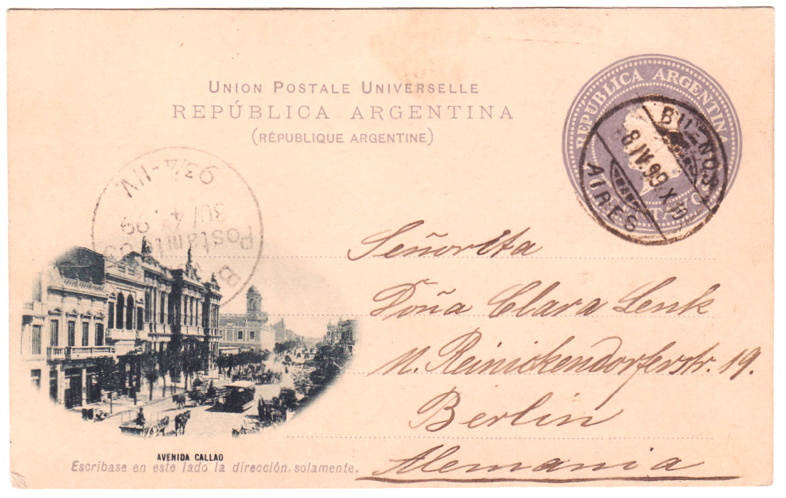 Circa 1870, Swiss postal administrators permitted Güller & Cie, the sole manufacturer of Swiss cancelers, to produce devices for other countries. The cancelers had to differ in appearance from regulation Swiss cancel design, so Güller created a different look for these foreign postal administrations. (This Buenos Aires canceler is one of the few exceptions to this rule.) It appears the company developed a style book from which designs could be chosen, then customized. Examples in this exhibit emphasize the variety Güller made for Latin American customers starting in 1881. Their common feature was the rotating date wheel invented by Güller in 1866. Post-1904 examples made for Argentina, Brazil, Uruguay and Venezuela, are of particular interest as they incorporated the new flexible-head design patented in 1903 by Swiss engineer Frédéric de Coppet.
Circa 1870, Swiss postal administrators permitted Güller & Cie, the sole manufacturer of Swiss cancelers, to produce devices for other countries. The cancelers had to differ in appearance from regulation Swiss cancel design, so Güller created a different look for these foreign postal administrations. (This Buenos Aires canceler is one of the few exceptions to this rule.) It appears the company developed a style book from which designs could be chosen, then customized. Examples in this exhibit emphasize the variety Güller made for Latin American customers starting in 1881. Their common feature was the rotating date wheel invented by Güller in 1866. Post-1904 examples made for Argentina, Brazil, Uruguay and Venezuela, are of particular interest as they incorporated the new flexible-head design patented in 1903 by Swiss engineer Frédéric de Coppet.
Link to single frame exhibit:
Swiss Made Cancelers Used in Latin America 1881-1936
This exhibit won a single frame Vermeil at SANDICAL 2016.
4 Comments
Chuck Wooster
February 27, 2018Roger,
I judged your exhibit at Ameristamp Expo and your synopsis mentioned that you have copies of a proof book showing all cancels made by this Swiss company. I collect Peru and wonder if this company made cancels for Peru and if I can obtain pdf’s from the proof book of them.
Thanks
Chuck Wooster
admin
February 27, 2018Hi Chuck,
Thanks for asking. Sorry, but Güller did not make cancels for Peru. The proof books were originally small lined paper notebooks. In 2000 these notebooks were photocopied and bound into large six large volumes at about 90% original size. They take about one foot of shelf space. I have been through the pages from the earliest circa 1870 to 1930 and don’t believe I have missed any foreign cancels. What makes foreign cancels easier to find was the Swiss post office’s requirement that Güller make cancels for other countries look different from Swiss cancels. So the foreign ones do stand out on the pages when looking at 40 or so impressions per page.
Thanks for your judging. Your email confirms to me the purpose of this exhibit which covers so much ground for a single frame exhibit. It was once suggested by a judge that I could do a 10 page exhibit on only the Mexican cancels. The answer of course is that that’s not the goal of the exhibit.
Bas PAYNE
April 15, 2022Hi: I’m working on South African date-stamps up to 1910 (Union). Small double-circle wheel-change date-stamps were first used in the Zuid Afrikaansche Republiek in 1894, and were in general use by 1900; squared circle wheel-change date-stamps were introduced at a few large offices (including Johannesburg and Pretoria) in 1898, and larger interrupted double circle wheel-change date-stamps were introduced a half a dozen large offices at about the same time. After the Boer War, the Transvaal continued to use wheel-change date-stamps until and after Union.
I have been trying to find out where these wheel-change date-stamps were made, but so far haven’t got anywhere. It seems likely that they were made in Europe – perhaps in Germany or Holland. I’d welcome any comments or information; and would be happy to send scans of examples.
admin
April 15, 2022Hello Bas,
I think most of the cancel in question were made by Güller & Cie of Hüttikon, Switzerland.
They are found most often on telegraph stamps used during the Boer War and also found less frequently on regular issue stamps, that might have been available in the telegraph offices. I’ve sent you scan via email showing how they were used.
The first is a sample from the Güller proof books of which I have a set. Güller didn’t include a proof image of every single “Telegraphs” date stamp shipped. In some places the book shows a single example from the shipment and include the number shipped. It looks like the first group was created in 1887, then a group in 1889, then 1892, a large group in 1897. Güller continued to make Telegraphs date stamps through 1904, then again from 1911 to 1915.
There are numerous examples of the large sizes of which I’m showing scans from the internet. Notice the British used the same series in Sudan!
The pdf at the bottom of this email includes some information from a revenue exhibit.
I’m not sure I can help much more than this since Güller didn’t include proofs of all the many Telegraphs they shipped, just samples from the groups, therefore, it is not possible to determine first use dates except for the few shown in the proof books. Too put it in perspective, there were hundreds shipped!